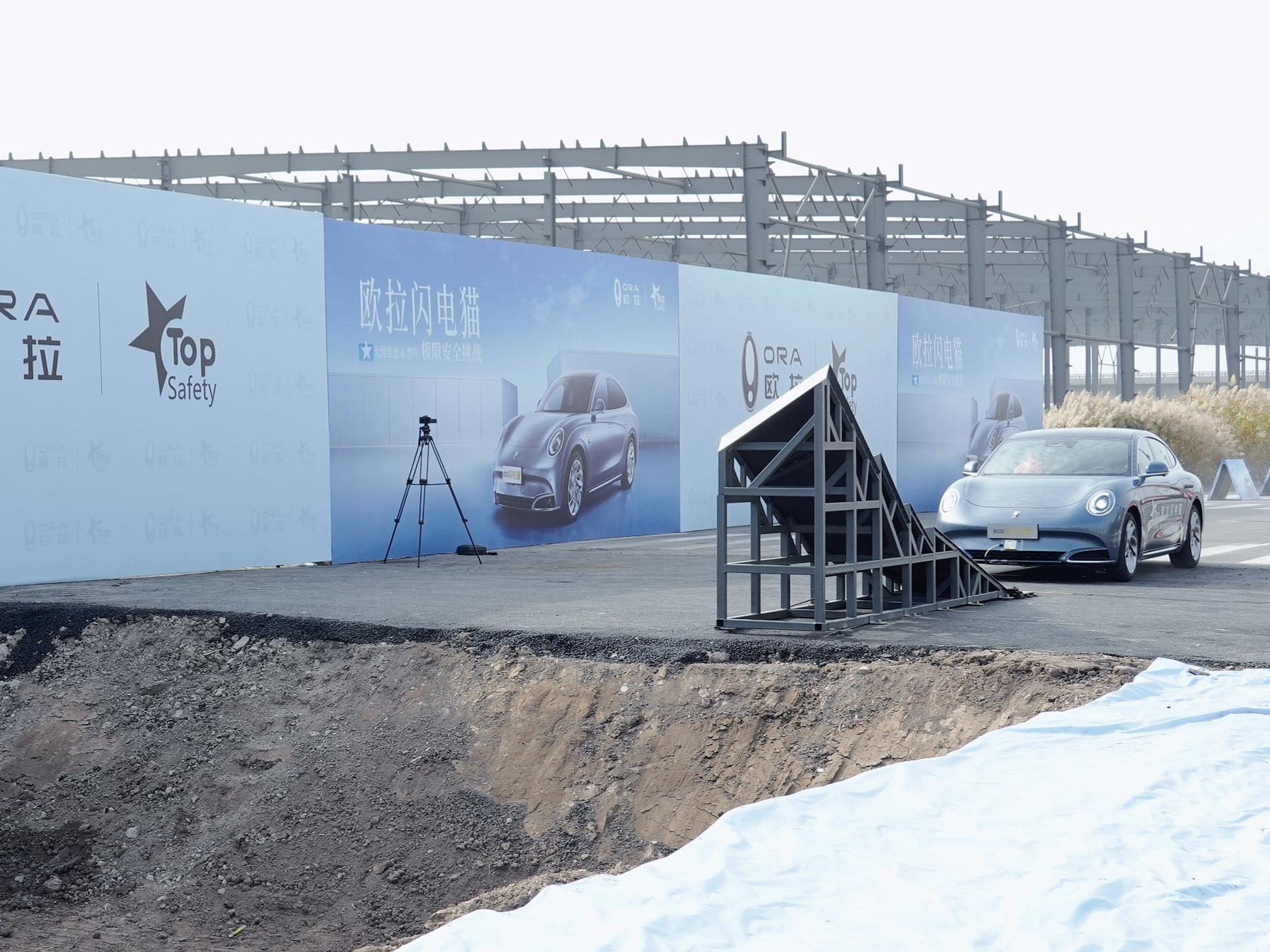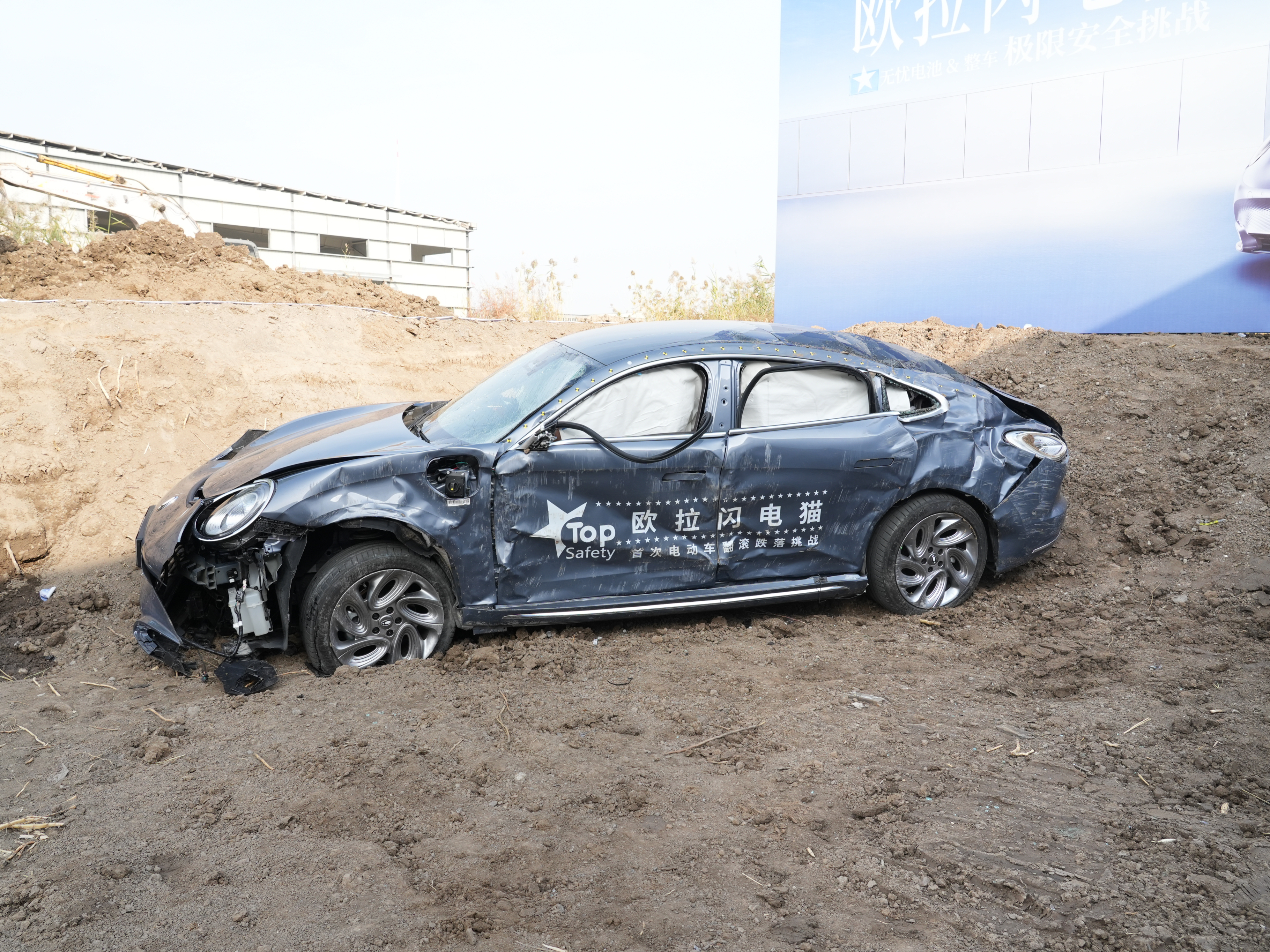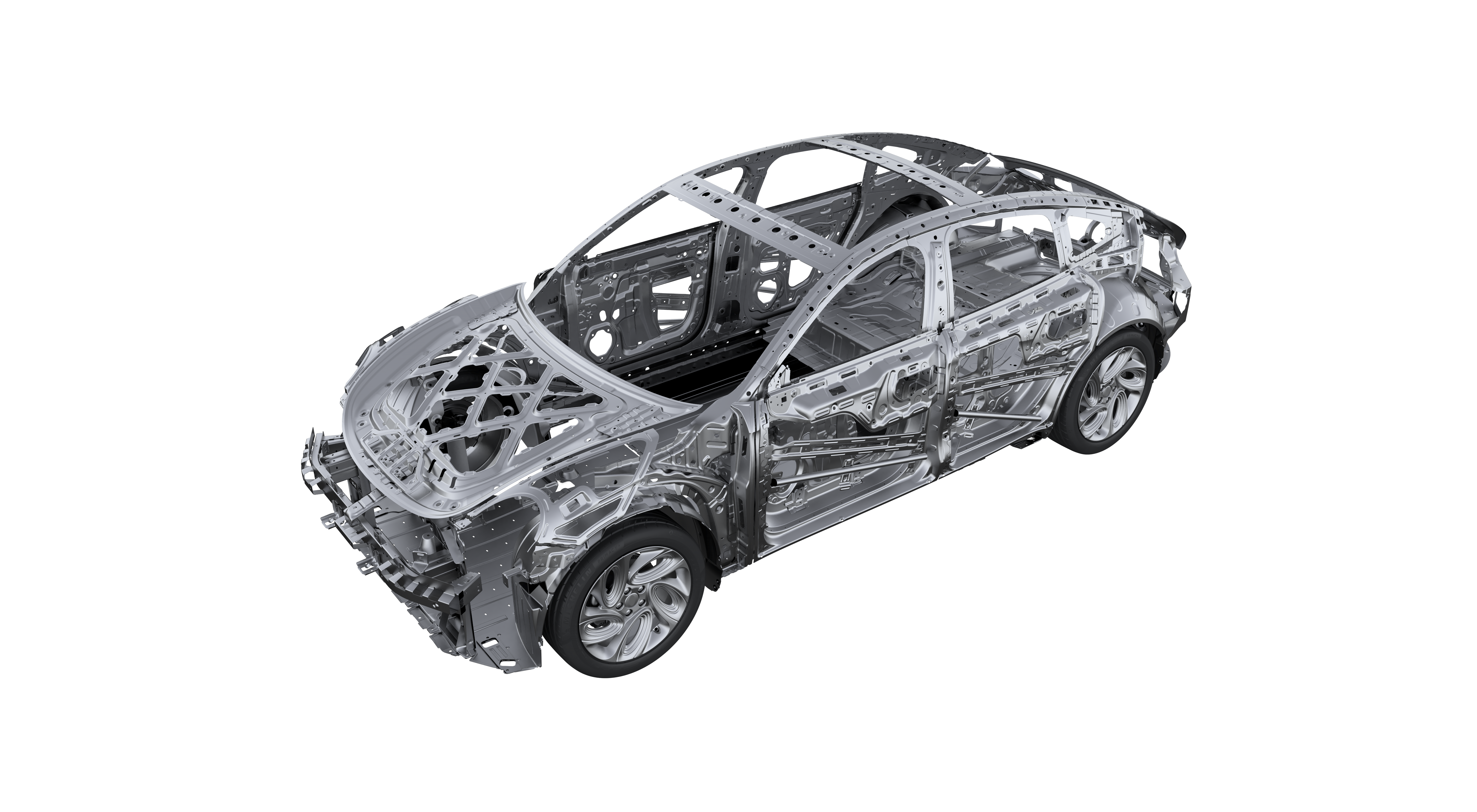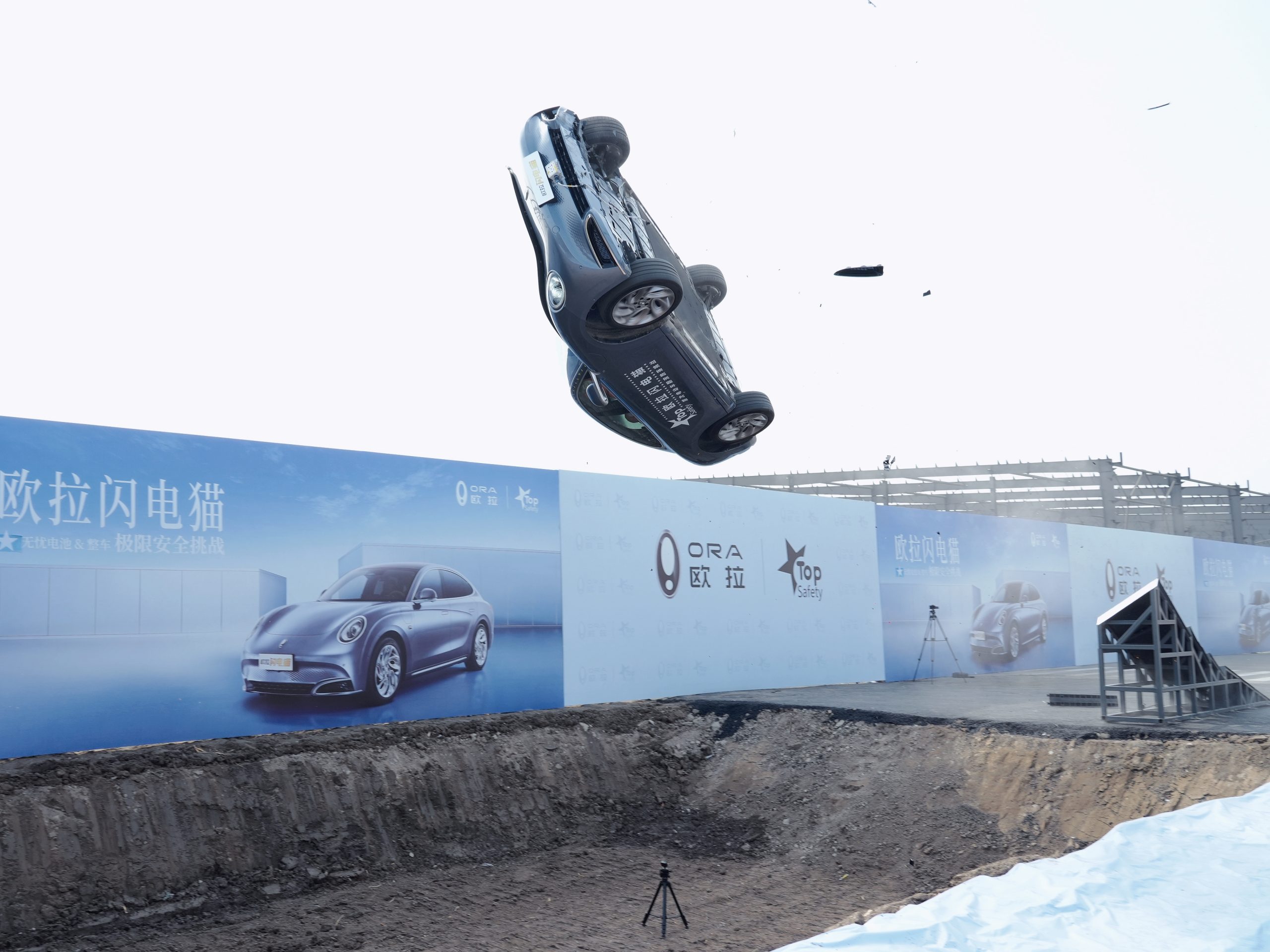On October 20th, Euler Lightning Cat participated in the first domestic electric vehicle high-speed spiral roll and fall challenge hosted by TOP Safety in a site authorized by the China Automotive Technology and Research Center.
The tested model for this challenge was the Euler Lightning Cat 555 km luxury version, equipped with “Wuyou battery”.
How to roll?
This was the first test in response to the corresponding working condition in the industry. In order to be closer to the road environment in daily use scenarios, this challenge simulated the situation where the vehicle lost control and rushed out of the guardrail on the high-speed road or urban fast ring overpass, fell off the overpass, and hit the ground, causing the whole vehicle to roll due to the huge impact, and comprehensively tested the vehicle structure, electric safety performance, and occupant injury, etc.

At the challenge site, Euler Lightning Cat turned off all intelligent driving assistance functions and was placed stationary 150 meters away from the one-sided bridge. It was driven by a driving robot at a speed of 60 kilometers per hour to rush onto the spiral one-sided bridge, roll over 540 degrees on the bridge, and fall into a tamped soil and hardened pit 40 meters long and 10 meters wide and 1.8 meters deep in front of it.
From the vehicle rushing out of the spiral one-sided bridge to falling into the pit, the maximum drop height from the highest point to the bottom of the pit exceeded 6 meters. After the fall, the huge kinetic energy drove the vehicle to continue to roll forward for 5 circles.
After the roll

After the test, the Lightning Cat experienced fierce impact landing and spiral rolling. The Wuyou battery quickly cut off the high voltage, without electrolyte leakage, burning and self-ignition, vehicle electrical leakage, etc. The electric safety evaluation items were successfully passed.
The integrity of the vehicle body structure was maintained, and the A/B/C pillars withstood the huge impact without collapse or deformation, and the passenger cabin remained intact.
Except for the removal of the safety airbag for installing the driving robot on the driver’s seat, all air curtains of the whole vehicle opened normally, providing protection for the occupants. The safety pre-tensioner function was triggered to firmly restrain the dummy on the seat, and the emergency rescue functions of hazard lights and E-CALL were activated normally. The passive safety evaluation items of the whole vehicle were also passed smoothly.
How to achieve it?
 The Euler Lightning Cat adopts a cage-type body design, and through the comprehensive optimization of the collision crush zone and high-strength cockpit area, multiple force transmission paths from the front, side, rear, and top merge together. The collision force from the front is transmitted through the longitudinal beam, upper beam (shotgun) to the A-pillar, sill, and middle channel.
The Euler Lightning Cat adopts a cage-type body design, and through the comprehensive optimization of the collision crush zone and high-strength cockpit area, multiple force transmission paths from the front, side, rear, and top merge together. The collision force from the front is transmitted through the longitudinal beam, upper beam (shotgun) to the A-pillar, sill, and middle channel.
The A/B/C pillars, seat crossbeam, and top cover crossbeam achieve a side circumferential structure, which can provide comprehensive safety protection. In the rollover test, the A/B/C pillars can participate in force transmission and provide support. The ring structures formed by the overlapping of the left and right pillars with the top cover crossbeam and seat crossbeam not only improve the body structure stiffness but also quickly and effectively transmit the force to the non-collision side to reduce the energy accumulation on the collision side. This effectively reduces the deformation of the passenger cabin and ensures the safety of the occupants.
On this basis, high-strength materials of the Euler Lightning Cat account for 77.6%, including 30.6% high-strength steel, 29.4% ultra-high-strength steel, and 17.6% hot-formed steel. Simulation optimization is carried out on the application of hot-formed steel in key areas such as A/B pillars, upper and lower beams, and top cover. Advanced 2,000 MPa hot-formed steel is used for the A/B pillars, and 1,500 Mpa hot-formed steel is used for the top cover crossbeam. The B-pillar is reinforced with fiber-reinforced composite materials to ensure strength and excellent bending performance.
The above designs are all to ensure the body stiffness, and to provide enough survival space for the occupants after the collision, protecting the structural integrity of the vehicle and the personal safety of the passengers.
Interestingly, panoramic skylights are basically used to ensure the riding space. In rollover accidents, if there is no beam to withstand the impact force, the entire roof is highly likely to collapse, posing a serious threat to the lives of passengers. The high-strength crossbeam added to the skylight of the Euler Lightning Cat plays a protective role.
Final Words
Everyone may ask, what is the significance of this test? From my perspective, I personally feel that this more intense test can more intuitively demonstrate the passive safety performance of the vehicle, especially in the comprehensive display of structural design, material use, and technology application.
After passing this extreme challenge, the Euler Lightning Cat will be stationary for 24 hours and disassembled in-depth. The disassembly video will be released online on October 24th.
As Euler’s first medium-sized pure electric sedan, and the product with the highest selling price and body size in the entire brand, the Euler Lightning Cat will officially go on sale at the end of October.
This article is a translation by ChatGPT of a Chinese report from 42HOW. If you have any questions about it, please email bd@42how.com.
